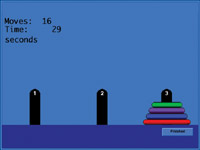This site contains educational and research materials.
The information is not intended to be medical advice.
Copyright © 2016 Learning Fundamentals, Inc. 805.544.0775
| < Back |
|
Next > |
|
Attention and Memory: Volume I
High Level Attention
The High Level Attention Module of Attention and Memory is the core group of exercises in our program for remediation of attention deficits due to attention deficit disorder, traumatic brain injury, and stroke. The tasks provide cognitive rehabilitation for four types of attention: sustained, alternating, divided, and focused. Many of your clients may need this module but not the rest of A&M, so it is available separately for purchase. Now your clients can work at home to get more therapy time.
Evidence Base: Attention training and training using compensatory aids have recently been supported in review papers as efficacious and an appropriate component of best practices in brain injury rehabilitation. The National Institutes of Health also recognized these approaches as efficacious in the position paper on rehabilitation after traumatic brain injury—Evidence-based cognitive rehabilitation: Recommendations for clinical practice (Cicerone, et. al., 2000).
Evidence Base: Executive function disorders and disorders of working memory affect an individuals ability to self-regulate behavior and use meta-cognitive strategies to adequately function in academic, social, and work-related situations. Empirical evidence indicates that treatment that strengthens the underlying cognitive processes generalizes to non-trained language-based tasks (Kohnert and Windsor, 2004).
Evidence Base: It appears that problems that Specific Language Impairment (SLI) children have in non-word repetition tasks are not related to encoding and analyzing word structure, but due to problems in divided attention (Marton and Schwartz, 2003).
Evidence Base: Exploratory research indicates that cognitive training in non-linguistic skills positively affects both L1 and L2 in bilingual Aphasia (Kohnert, 2004).
Evidence Base: Evidence exists to demonstrate a link between verbal working memory and Specific Language Impairment (Montgomery, 2002).
Benchmark Grades 6-8: Understands that paying attention to any one input of information usually reduces the ability to attend to others at the same time. Knows that it is difficult to concentrate on two different things at the same time.
Evidence Base: Children with speech and language delays must receive treatment in their primary language in order for it to be maximally effective (Goldstein, 1999; Gutierrez-Clellen, 1999).
Benchmark Foreign Language: Uses basic vocabulary to describe assorted objects (e.g., toys, dress, types of dwellings, foods) in everyday environments. Uses vocabulary for a wide range of topics. Uses the target language to engage in conversations, express feeling and emotions, and exchange opinions and information.
|
| < Back |
|
Next > |

